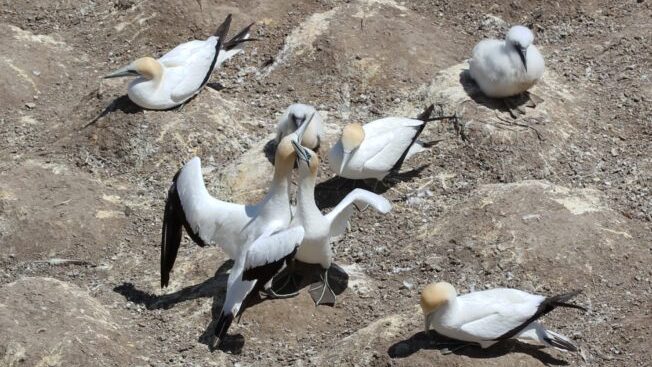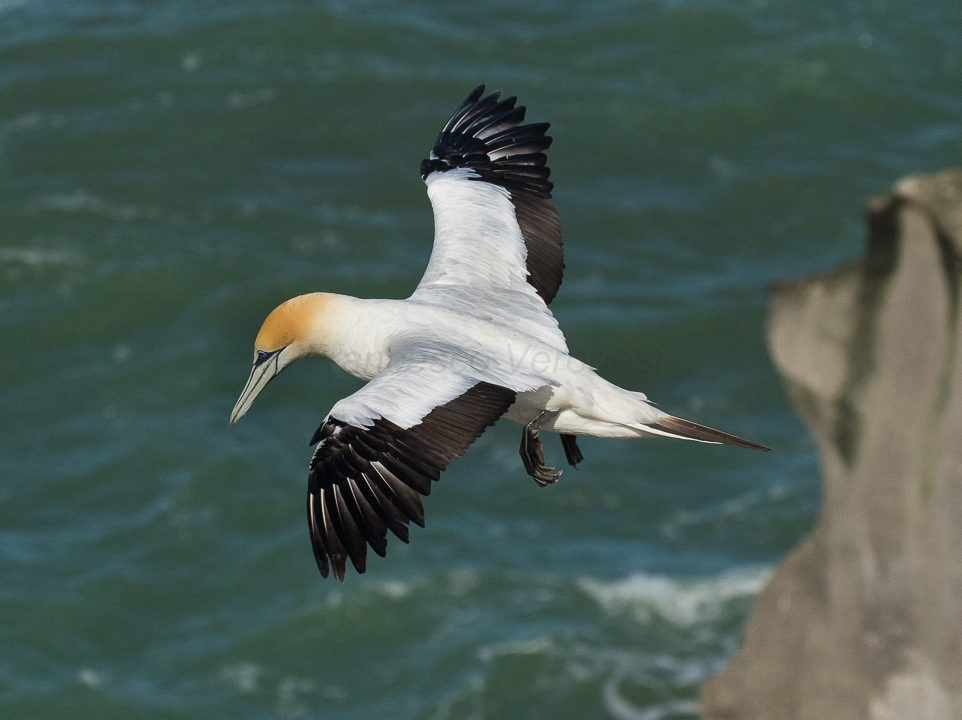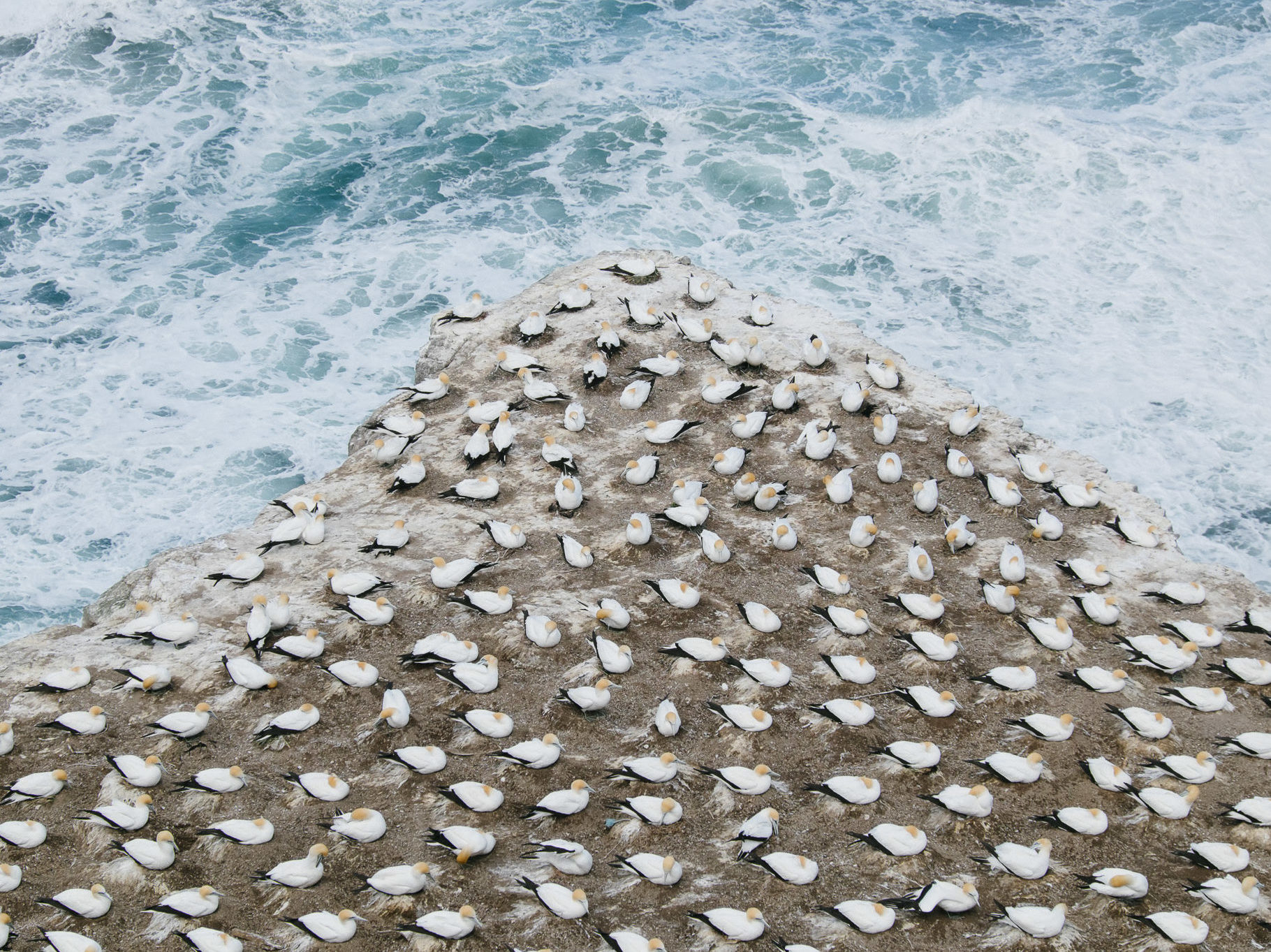Ocean plastic is a worldwide problem – and its impacting wildlife here in New Zealand too. A recent study checked out how much plastic is turning up in gannet nests at a Hauraki Gulf gannetry and found an alarming 86% of nests had at least some plastic included in their construction!

Nigel Adams, Chris Gaskin and Edin Whitehead were the researchers checking up on gannet nests.
“Our objective was to determine the extent and nature of plastic debris in the nests of Australasian gannets at Horuhoru Island in the inner Hauraki Gulf, New Zealand. This may provide an indication of the likely risk of entanglement and the prevalence of plastic, particularly fishing debris in the surrounding gulf.”
Plastics have been recovered worldwide from the digestive tracts of coastal and pelagic seabirds or from around their nests demonstrating that plastics are ubiquitous across all oceans. Birds are often used as indicators for the distribution and relative amount of marine plastic debris.
“Seabirds are impacted by plastics through the consequences of ingestion and entanglement, The likelihood of different types of impacts on species are related to their feeding behaviour, Gannets feed by a combination of plunge diving and underwater pursuit. Although diving seabirds, including gannets, have been recorded with ingested plastics direct ingestion of mostly floating plastic debris is generally less likely than for surface feeding birds. However, several studies have noted that the incorporation of marine debris, particularly fibres, cord, or rope manufactured from plastics, occurs in the nests of both northern (Morus bassanus) and Australasian (tākapu, Morus serrator) gannets.

Having plastic ropes and other debris as part of nest material puts adults and particularly chicks at risk of entanglement.
“Entanglement may occur around the mandible of gannets, when feeding or manipulating nesting material, or around the legs and feet on plastic that has been used in nest construction.”
Gannets are coastal feeding seabirds, and may encounter debris arising from commercial or recreational fishing as well as terrestrial sources.
“Commercial fishing is focussed in the outer gulf, but does occur within the inner Hauraki Gulf and includes bottom longlining, set netting, and trawling. In addition, due to its proximity to the largest urban area in New Zealand, recreational boating and fishing effort in the gulf is high. This coupled with the semi-enclosed nature of the water body may result in plastic debris persisting in the area,” say the researchers.
This study was conducted at Horuhoru (Gannet Rock), 1.5 km off the north east corner of Waiheke Island in the inner Hauraki Gulf.
“The gannet colony is located along the top of the main ridge of the islet and on the east-facing slopes of Horuhoru. The west-facing side of the rock falls off as a cliff and is not suitable for nesting. We conducted our nest checks on 12 January 2019 when the colony contained a total of 134 chicks.”
It is likely that a number of chicks had already fledged by the time the nest examinations were carried out.
“To minimise disturbance to remaining birds we examined nests at the lowest section of the colony on the east facing slope. In this part of the colony chicks had moved away from their nest sites to form small crèches. We examined all 57 nest pedestals in the area.”
“For each nest we recorded the number of plastic items that formed part of the nest. We did not distinguish between polypropylene, nylon, and polyester ropes or cords. These items were classified into braided plastic cord, plastic threads, knot clumps of plastic cord, and packaging straps. Tangles consisted of individual threads of plastic that had become twisted together into an inseparable bundle. Knots were short pieces of plastic cord that had been deliberately knotted.
The researchers measured the length of the plastic items and recorded their colour. They only recorded details from plastic that was visible and did not probe nests for plastic waste.
“A total of 49 (86%) of the 57 nests examined contained plastic. Most of the items of plastic recovered (N = 125) consisted of braided cord or individual threads most likely derived from the cord. Many of the plastic items were black (56%) with other darker colour items (black combination and blue) comprising another 29.6%. The average length of plastic cord or threads was 21.6 ± 1.2 cm.”
The inner Hauraki Gulf findings were high compared with a similar study carried out in Australia.
“The prevalence of plastic debris in nests at Horuhoru was substantially higher than the 28.4% of nests of the same species at three colonies in Victoria, Australia. It was also higher than the 46% averaged across 29 northern gannet colonies that contained marine debris, including plastics although values at some colonies was substantially higher. For example, 97% of all nests examined across two Northern gannet colonies in Newfoundland, Canada in 1988 and 1989 and 80% of nests in a Welsh colony in the western Atlantic contained plastic debris.”
“Our nests represented a group of neighbouring nests on the periphery of the colony, and so may not be representative of the whole colony. By not probing nests for debris, we may have underestimated plastic prevalence. In the Australian study, Norman et al. (1995) noted that in one of three colonies the central nests, presumed to be older established nests, contained more plastic items than more peripheral nests.”
Seaweed and guana are used by gannets to construct their nests. Could the birds be using plastic rope because of its similarity to seaweed strands?

Seaweed and guana are used by gannets to construct their nests. Could the birds be using plastic rope because of its similarity to seaweed strands?
“Australasian gannets build nests from a combination of guano deposited by birds over time and material, such as strands of seaweed, collected at sea by male birds. Although individuals will pilfer seaweed from nearby nests or birds, most seaweed is likely collected from the surface of surrounding waters. While some recycling of plastic by birds is likely to occur through pilfering within the colony, our data suggest that plastic marine debris is frequently encountered by gannets in the inner Gulf and more often than that of Australasian gannets in Victoria in the early 1990s. In the absence of historical data from Horuhoru it is unclear whether this reflects an increase in plastic debris over time across the species range and/or differences in the local conditions between the two sites.”
During their investigation, the researchers did not find any gannets actually entangled in the plastic – some good news at least.
“Despite its high prevalence in nests we noted no entanglement of gannets by plastic in January 2019. During three visits over three consecutive breeding seasons to the colonies at Horuhoru and Mahuki Island (in the outer gulf) we noted only a single case of entanglement involving a bundle of plastic threads wound around the lower bill of an adult gannet. Higher entanglement rates have been recorded for some populations of northern gannets. Votier et al. (2011) noted that nestlings were most at risk and that once entangled, mortality rate was high. However, the total numbers of birds affected remained relatively small and was considered to have little population level effect.”
In other research, at-sea surveys conducted in the non-breeding season have also shown that immature northern gannets are more likely to be impacted. At one sampling location 20.2% of observed birds had some plastic entanglement.
“Much of the plastic encountered by Australasian gannets in the Hauraki Gulf is likely derived from discharged fishing gear, boat gear, or possibly mariculture operations that are located nearby. In contrast to some studies on northern gannets, we did not recover pieces of plastic fishing nets from gannet nests at Horuhoru.”
Plastic pollution seems to be high in the inner Hauraki area.
“We conclude the high prevalence of plastic at gannet nests at Horuhoru indicates these plastics are common in the surrounding waters although incorporation of plastic into nests may also be affected by the availability of seaweed as nesting material. While plastic debris was common in gannet nests at Horuhoru the number of discrete items per nest was low (125 items from 57 nests).”
“At present levels the risk of plastic entanglement of gannets breeding at Horuhoru seems low compared to other northern gannet colonies. Future surveys should indicate whether prevalence and abundance of plastic marine debris in nests increases, along with the associated risks of entanglement, and by expanding to other colonies whether the inner Gulf waters are particularly polluted with plastic marine debris.”
The full research article is published in Notornis, the research journal of Birds New Zealand (formerly the Ornithological Society). Articles are freely available to non-subscribers one year after publication. Earlier access may be available through local public libraries.
Marine debris in the nests of tākapu (Australasian gannets, Morus serrator) in the inner Hauraki Gulf, New Zealand (2020)

